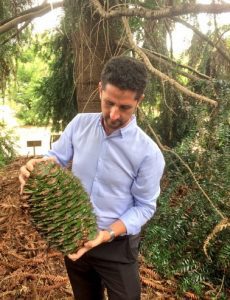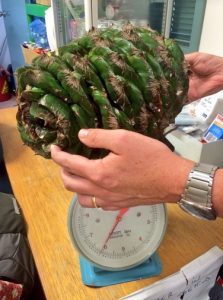
Summer heralds the sounds of loud thuds at the Australian Botanic Garden Mount Annan, as the Bunya Pine begin to drop their cones.
This year the large cones have already started to hit the ground but only time will tell if this is going to be a bumper crop and break records.
The Bunya Pine (Araucaria bidwillii) is a native of the subtropical rainforests in the mountains in south-east and northern Queensland and closely related to Australia’s other living fossil the Wollemi Pine.
The Bunya Pine can grow up to 35-45 metres in height and live for 600 years.
The nuts can be 20-35 cm in diameter and weigh up to 10 kg, yielding enough seeds for a bush tucker feast.
It has been a sacred tree for indigenous Australians for a long time and an important source of food, kindling, timber and fibre.
Perhaps not as well known as pine nuts, the Bunya Pine’s large edible seeds can be eaten raw, roasted or cooked in hot coals to make bread.
The tree has many other common names in various aboriginal dialects such as Bunya-bunya, Banza-tunza, Banua-tunya, Boonya, Bunyi, Bahnua, Bunya, and Bonyi-bonyi.
The importance of the tree and nut as food wasn’t lost on early European settlers, reminding them of roasted chestnuts from home.
In the past century, Australian companies like Maton and Cole Clark Guitars have discovered that the timber of a Bunya Pine is ideal for making exceptional acoustic musical instruments.
Historically the evergreen conifer was commonly planted around homesteads, including in the Macarthur area of South West Sydney.
Over the years our backyard gardens have reduced in size and it is no longer possible for most people to grow their own tree.
[social_quote duplicate=”no” align=”default”]“At the Australian Botanic Garden we decided to plant a number of these trees to ensure that it continues to be a signature plant for the area,’’ says John Siemon, curator manager of the Australian Botanic Garden Mount Annan.[/social_quote]
“Although visitors can see the Bunya Pines at the Garden, we do fence them off once they start to produce nuts to ensure public safety.
 “We hope that in years to come you’ll be able to see them marching along the ridge as you drive down the motorway that passes by the Garden.’’
“We hope that in years to come you’ll be able to see them marching along the ridge as you drive down the motorway that passes by the Garden.’’
The Australian Botanic Garden Mount Annan is Australia’s largest botanic garden, covering 416 hectares.
The Garden features an amazing living collection of flora from around Australia.
The collection is just the tip of the science and conservation role at the Australian Botanic Garden Mount Annan.
It is also at the forefront of plant research, being home to Australian PlantBank – the Noah’s Ark of the seed world, if you may.
The Australian Botanic Garden Mount Annan is a bit of a hidden gem but absolutely worth the visit – for your first time or the 100th.
And it’s absolutely free to get into and explore.




Peat Alderson Bunyip Men